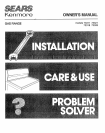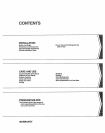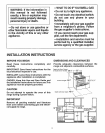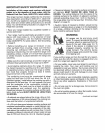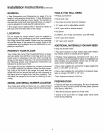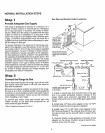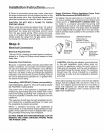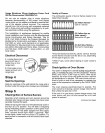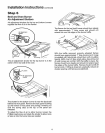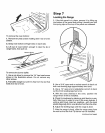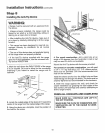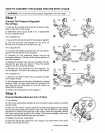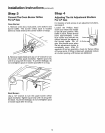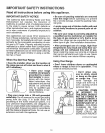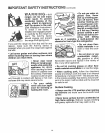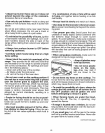
installation Unstructions (coothued)
5. When all connections have been made, make sure
all range controls are in the off position and turn on the
main gas supply valve Use a liquid leak detector at all
joints and connections to check for leaks in the system,
CAUTION: DO NOT USE A FLAME TO CHECK
FOR GAS LEAKS.
When using test pressures greater than 1/2 psig to
pressure-test the gas supply system of the residence,
disconnect the range and individual shut-off valve
from the gas supply piping. When using test pres-
sures of 1/2 psig or less to test the gas supply system,
simply isolate the range from the gas supply system
by closing the individual shut-off valve
Step 3
Electrical Connections
Electrical Requirements:
120-volt, 60-Hz, properly grounded branch circuit pro-
tected by a 15-amp or 20-amp circuit breaker or time-
delay fuse
Extension Cord Cautions:
Because of potential safety hazards associated with
certain conditions, we strongly recommend against
the use of an extension cord. However, if you still elect
to use an extension cord, it is absolutely necessary
that it be a UL-listed, 3-wire grounding-type appliance
extension cord and that the current carrying rating of
the cord in amperes be equivalent to, or greater than,
the branch circuit rating
Grounding--IMPORTANT (Please read carefully):
FOR PERSONAL SAFETY, THIS APPLIANCE MUST
BE PROPERLY GROUNDED..
The power cord of this appliance is equipped with a
three-prong (grounding) plug that mates with a stan-
dard three-prong grounding wall receptacle to mini-
mize the possibility of electric shock hazard from this
appliance°
The customer should have the wall receptacle and cir-
cuit checked by a qualified electrician to make sure
the receptacle is properly grounded
Where a standard two-prong walt receptacle is
encountered, it is the personal responsibility and obli-
gation of the customer to have it replaced with a prop-
erly grounded three-prong wall receptacle,
DO NOT, UNDER ANY CIRCUMSTANCES, CUT OR
REMOVE THE THIRD (GROUND) PRONG FROM
THE POWER CORD.
Usage Situations Where Appliance Power Cord
Will Be Disconnected INFREQUENTLY:
An adapter may be used only on a 15-amp circuit, Do
not use an adapter on a 20-amp circuit. Where local
codes permit, a TEMPORARY CONNECTION may
be made to a properly grounded two-prong wal!
receptacle by the use of a UL-listed adapter, available
at most hardware stores. The larger slot in the adapter
must be aligned with the larger slot in the wall recep-
tacle to provide proper polarity in the connection of the
power cord°
PREFERRED METHOD
_ nsure prope_
ground exists
before use
TEMPORARY METHOD
Adapter plugs not
permitted in Canada
Align large prongs!slots _7-"_
L {tJ groundand
]'11¥ firm connection
"_ before use
CAUTION: Attaching the adapter ground terminal
to the wall receptacle cover screw does not
ground the appliance unless the cover screw is
metal and not insulated, and the wall receptacle is
grounded through the house wiring. The customer
should have the circuit checked by a qualified
electrician to make sure the receptacle is properly
grounded..
When disconnecting the power cord from the adapter,
always hold the adapter with one hand If this is not
done, the adapter ground terminal is very likely to
break with repeated use. Should this happen, DO
NOT USE the appliance until a proper ground has
again been established



